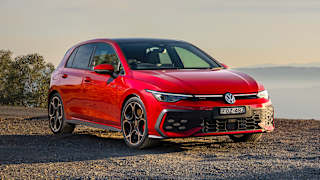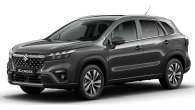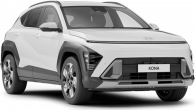Technically, Mazda sells an entry-level CX-3 for around 20 grand, but it doesn't really sell it, if you know what we mean.
Sure, Mazda advertises a mighty-tempting Neo for that money, but nobody actually buys it, inevitably opting to part with a little more cash for a better-looking, better-equipped model once they actually venture into a dealership.
In fact, of the four-strong CX-3 lineup, 56 per cent of buyers opt for the more expensive Maxx - which is $24,890 for the auto model we've tested here - compared to the lower-spec Neo, which makes up just seven per cent of sales.
So the question now is, are they making the right choice?
Mazda CX-3 2017: Maxx (FWD)
| Engine Type | Inline 4, 2.0L |
|---|---|
| Fuel Type | Unleaded Petrol |
| Fuel Efficiency | 6.1L/100km (combined) |
| Seating | 5 |
| Price From | $17,490 - $22,110 |
| Safety Rating |
|
Is there anything interesting about its design?
8 / 10
While some of the Japanese brands are in the habit of throwing the book at every possible part of a car's interior, Mazda goes exactly the other way, perfecting a kind of minimalist approach to interior design.
And so you'll find no button-festooned stereo or weird design elements in the cabin of the CX-3. Instead, it's a clean and simple layout, with Mazda's 7.0-inch touchscreen perched above an entirely uncluttered dash, which scores a thoughtful soft-touch panel that helps disguise the hard plastics and lifts the general interior ambience.
Outside, there's a lot to like with Mazda's design, from the sporty and hunkered-down glasshouse - which appears to be perched on the wheelbase like a sprinter crouched on the starting block - to the clean lines of the bonnet and grille. It looks smaller than some of its competitors, sure, but it's more stylish than most, too.
.jpg)
How practical is the space inside?
7 / 10
If the 4275mm long and 1765mm wide CX-3 looks small from the outside, it feels that way inside, too.
That said, up-front passengers get enough room to spread out a little, and it never feels dark or claustrophobic thanks to the bright and airy cabin feel. Front-seat riders will share two cupholders, along with two USB points, an SD card reader and power source, and there's room in each door for bottles, too.
Things are a little grim and cramped for backseat riders, though. You'll never get three adults in the back comfortably, and even a big baby seat will dominate the space back there, spreading across both the window and middle seat. Helpfully, legroom is good behind the front seats, but it's the shoulder room that feels tight, not helped by the fact that the rear door panels are thick and more than a little intrusive.
There are no cupholders, or air vents, or USB outlets in the backseat, either, but there are pockets in each door, along with two ISOFIX attachment points, one in each window seat.
Boot space is small but useable, especially for weekend trips, and the 60/40 rear seats improve matters, expanding luggage space from 264 litres to 1174 litres when folded flat.
.jpg)
Does it represent good value for the price? What features does it come with?
8 / 10
The Maxx occupies the second rung on the CX-3 ladder, above the price-led Neo and below the sTouring and top-spec Akari.
That $24,890 - $2k less if you choose the manual, and $2k more if you want to add all-wheel drive - buys you 16-inch alloys (upgraded from the steel wheels on the Neo), a chrome exhaust tip and a rear spoiler outside, while inside, you'll find cloth seats, a leather-wrapped steering wheel and a nav-equipped, 7.0-inch touchscreen that pairs with an upgraded six-speaker stereo. Cruise control and push-button start round out the best of the standard features list.
.jpg)
The CX-3 also gets Mazda's driveability updates - namely a focus on a reduction in NVH and the addition of the brand's 'Torque Vectoring Control' system - right across the range.
Crucially, you'll also score some key safety upgrades, but we'll drill down on those under the safety sub-heading.
What are the key stats for the engine and transmission?
8 / 10
There are just the two engines available across the CX-3 range, with a 1.5-litre diesel joining the 2.0-litre petrol four we've tested here.
The 1998cc petrol unit will produce 109kW at 6000rpm and 192Nm at 2800rpm, channeling its power through a six-speed conventional automatic and on to the front wheels. It's a perky little engine, and feels well suited to the CX-3 Maxx's 1282kg kerb weight.
How much fuel does it consume?
7 / 10
Mazda claims fuel use of 6.1L/100km for the combined cycle, and the CX-3 Maxx will happily drink 91RON fuel, or E10, for that matter. Emissions are pegged at 146g/km of C02.
What's it like to drive?
8 / 10
Its size might count against it on the practicality front, but it's a boon on the road, with the CX-3 feeling sharp and dynamic when you're on the move.
While the on-paper specs won't set pulses racing, the old school power delivery means you're never waiting for turbochargers or for tricky gearboxes to figure out what they're doing. Instead, it's a simple point-and-shoot set-up that suits the Maxx perfectly.
It ticks plenty of on-road boxes often ignored in the small SUV segment.
It's built for the city, and the Maxx disposes of paper-thin alleyways and too-small parking spaces with ease. It's bright and airy from the driver's seat, too, and the vision is terrific out of all windows expect the back one, which is weirdly angled and does hurt rear vision.
Even without engaging sport mode, which seems to do little but hang onto a lower gear just long enough to become annoying, the CX-3 feels plenty dynamic, even if you leave the city in search of a twisting road. The steering feels connected and responsive, while the firm-ish suspension lets you know what's happening underneath.
It's not always the most refined drive, though, and the gearbox can feel like it's surging - especially when you first get moving - and it's still not particularly quiet. But it ticks plenty of on-road boxes often ignored in the small SUV segment.
Warranty & Safety Rating
What safety equipment is fitted? What safety rating?
9 / 10
The CX-3's standard safety credentials are first class, with even the base-level Neo offering dual front, side and curtain airbags, along with rear parking sensors, hill start assist and an AEB system that works whether your travelling forwards or backwards. In fact, a reversing camera is the only notable exclusion.
Spring for the Maxx, though, and you'll add the camera, along with blind-spot monitoring and rear cross-traffic alert. All of which help secure the CX-3 a maximum five-star ANCAP rating.
What does it cost to own? What warranty is offered?
7 / 10
The CX-3 Maxx is covered by Mazda's standard three-year/unlimited-kilometre warranty, - which does now lag behind the industry leaders - with service intervals pegged at 12 months or 10,000km.
Capped-price servicing is thrown in, too, with Mazda's customers able to access all servicing costs on the brand's website.
Verdict
The words small but perfectly formed could have been written for the CX-3 Maxx, which offers a lot more bang for not many more bucks when compared to its cheaper Neo sibling. It's probably our favourite driving small SUV, too, even if it's not as great at carrying stuff (or more than two adults) as some of its competition.
Is Mazda's mid-range CX-3 the compact SUV for you? Tell us what you think in the comments below.
Pricing Guides







.jpg)
.jpg)
.jpg)
.jpg)
.jpg)
.jpg)

.jpg)
.jpg)
.jpg)
.jpg)
.jpg)
.jpg)
.jpg)
.jpg)
.jpg)
.jpg)



.jpg)







.png)











.jpg)


.jpg)